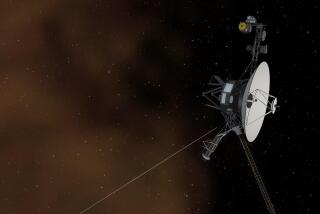Rise and shine Rosetta! Comet-hunting spacecraft gets wake-up call
After 31 months of electronic slumber, the Rosetta spacecraft awoke to a pre-programmed alarm Monday and signaled anxious ground controllers that it had indeed woken up on schedule.
“This was one alarm clock not to hit snooze on,” said Fred Jansen, manager of the European Space Agency‘s Rosetta mission. “After a tense day we are absolutely delighted to have our spacecraft awake and back online.” (Watch an animated video of the wake-up sequence here.)
PHOTOS: Amazing images from space
Rosetta and its on-board lander, Philae, are scheduled to become the first-ever probes to attempt a landing on the surface of a comet this November. The probe, which was launched 10 years ago, is pursuing Comet 67P/Churyumov-Gerasimenko.
ESA controllers in Darmstadt, Germany, shut down nearly all of the spacecraft’s systems in June 2011 because it had traveled so far from the sun that its solar array was unable to generate all the power it required. A pre-programmed “alarm clock” reactivated the spacecraft on Monday however, after its orbit brought it closer to the sun.
“After warming up its key navigation instruments, coming out of a stabilizing spin, and aiming its main radio antenna at Earth, Rosetta sent a signal to let mission operators know it had survived the most distant part of its journey,” the ESA said in a press release.
That signal was received by NASA’s Goldstone ground station, in California’s Mojave Desert, at 10:18 a.m. PST, as well as the Canberra, Australia, ground station. (The ground stations are part of the Deep Space Network, which is managed by NASA’s Jet Propulsion Laboratory in La Canada Flintridge. The DSN’s third station is located in Madrid, Spain.)
Rosetta remains more than 5 million miles from its quarry, and is not expected to rendezvous with Comet 67P/Churyumov-Gerasimenko until August. At that point it will begin mapping the comet’s surface, measuring its gravity and analyzing its coma -- the cloud of gas and debris that surrounds a comet as it travels near the sun.
Then, in mid-November, the spacecraft will disgorge the Philae lander, which will secure itself to the surface of the comet with screws and harpoons. Once in place, Philae will drill into the comet and study its composition.
Aster kometes, or “long-haired stars” as the Greeks called them, have long captured the public’s imagination. It’s only recently however that scientists have begun to understand their origins and composition.
Often described as “dirty snowballs,” comets are leftover debris from the formation of the solar system, according to scientists, and likely “seeded” earth with water. Others speculate that they may have delivered the basic ingredients for life.
“All other comet missions have been flybys, capturing fleeting moments in the life of these icy treasure chests,” said Matt Taylor, a Rosetta project scientist, in a press release.
“With Rosetta, we will track the evolution of a comet on a daily basis ... for over a year, giving us a unique insight into a comet’s behavior and ultimately helping us to decipher their role in the formation of the solar system,” he said.







